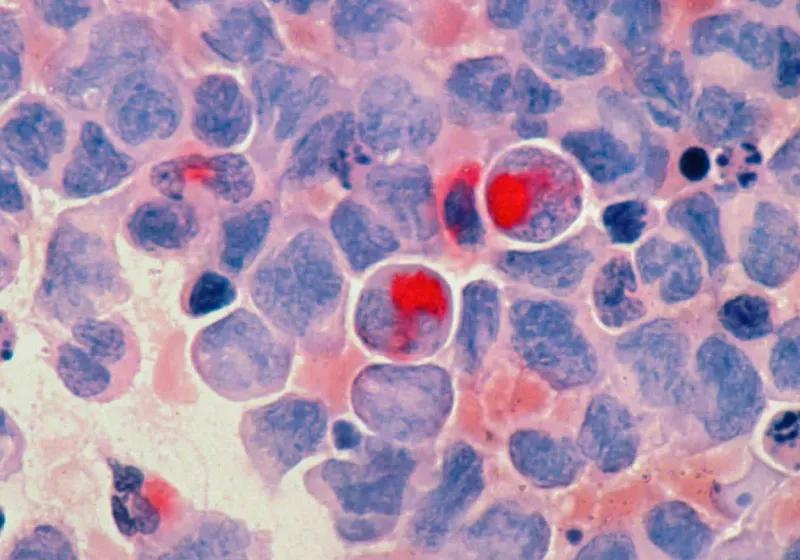Chan Zuckerberg Initiative Unveils GREmLN: A Revolutionary AI Model for Decoding Cellular Behavior
3 Sources
3 Sources
[1]
Chan Zuckerberg initiative unveils AI model to decode cellular behavior
Chan Zuckerberg InitiativeJul 10 2025 Today, the Chan Zuckerberg Initiative (CZI) announced its latest AI model aimed at helping researchers better understand how cells behave by focusing on the key networks that control cell behavior, making complex biological problems, like cancer, easier to solve. The model, GREmLN (Gene Regulatory Embedding-based Large Neural model), is a milestone in CZI's grand challenge to build a family of AI biomodels that predict and understand how cells work at every level - from molecules to entire biological systems - and help scientists cure, prevent, and manage all disease. GREmLN is designed to help researchers identify how the genes of a cell work together - and what can make them go awry, giving way to diseases such as cancer or neurodegeneration. GREmLN is a novel approach to understanding how cells make decisions and, just as importantly, how those decisions go wrong in diseases like cancer. Our model provides an approach, grounded in biology, to leverage AI for deriving new insights into health and disease. This model doesn't try to reshape biology to fit AI, it reshapes AI to fit biology." Andrea Califano, president of the Chan Zuckerberg Biohub New York and Clyde and Helen Wu professor of chemical and systems biology at Columbia University Vagelos College of Physicians and Surgeons Unlike most AI models, GREmLN focuses on the "molecular logic" that defines how genes interact and influence each other, similar to a conversation inside the cell. It will give scientists a way to track the critical changes that pinpoint the earliest signs of disease and the possible targets for new treatments. GREmLN is trained on more than 11 million data points from Chan Zuckerberg CellxGene, a tool used by thousands of scientists every week to help make discoveries faster by exploring and comparing data from individual cells that span tissues like the brain, lung, kidney, and blood. Soon the model will be scaled up to help address critical biological and medical questions, so that researchers may detect the early signs of a cell turning cancerous or of a neuron starting to accrue damage - before these changes become irreversible. "Understanding cellular behavior means understanding the network of conversations happening inside every cell," said Theofanis Karaletsos, senior director of AI at CZI. "GREmLN captures that complexity in a way we've never been able to before. It's a step toward building systems that help us simulate and predict the behavior of cells." In the future, GREmLN could power a wide range of research applications, from blocking the ability of cancer cells to evade therapy to preventing inflammation from producing irreversible damage to our brain cells. It could also help researchers predict how cells will react to new drugs and eventually dramatically increase the success of those drugs in clinical trials. Ultimately, GREmLN is part of a new wave of AI tools designed to help scientists understand the complex logic of life itself. GREmLN joins a suite of biomodels built by CZI and its Biohubs, including the recently released TranscriptFormer, the first generative AI model to bring together datasets of different species at scale with the goal of helping researchers explore how cells work. Both models have broad applications for biomedical research, disease diagnosis and therapeutic development. The models are part of the organization's virtual cell platform, which is open and accessible to the global scientific community. Chan Zuckerberg Initiative
[2]
New AI model could help scientists pinpoint signs of cancer cells
The Chan Zuckerberg Initiative (CZI) reports its latest AI model aimed at helping researchers better understand how cells behave by focusing on the key networks that control cell behavior, making complex biological problems, like cancer, easier to solve. The model, GREmLN (Gene Regulatory Embedding-based Large Neural model), is a milestone in CZI's grand challenge to build a family of AI biomodels that predict and understand how cells work at every level -- from molecules to entire biological systems -- and help scientists cure, prevent, and manage all disease. Details are published on the pre-print server bioRxiv. GREmLN is designed to help researchers identify how the genes of a cell work together -- and what can make them go awry, giving way to diseases such as cancer or neurodegeneration. "GREmLN is a novel approach to understanding how cells make decisions and, just as importantly, how those decisions go wrong in diseases like cancer," said Andrea Califano, president of the Chan Zuckerberg Biohub New York and Clyde and Helen Wu professor of chemical and systems biology at Columbia University Vagelos College of Physicians and Surgeons. "Our model provides an approach, grounded in biology, to leverage AI for deriving new insights into health and disease. This model doesn't try to reshape biology to fit AI, it reshapes AI to fit biology." Unlike most AI models, GREmLN focuses on the "molecular logic" that defines how genes interact and influence each other, similar to a conversation inside the cell. It will give scientists a way to track the critical changes that pinpoint the earliest signs of disease and the possible targets for new treatments. GREmLN is trained on more than 11 million data points from Chan Zuckerberg CellxGene, a tool used by thousands of scientists every week to help make discoveries faster by exploring and comparing data from individual cells that span tissues like the brain, lung, kidney, and blood. Soon the model will be scaled up to help address critical biological and medical questions, so that researchers may detect the early signs of a cell turning cancerous or of a neuron starting to accrue damage -- before these changes become irreversible. "Understanding cellular behavior means understanding the network of conversations happening inside every cell," said Theofanis Karaletsos, senior director of AI at CZI. "GREmLN captures that complexity in a way we've never been able to before. It's a step toward building systems that help us simulate and predict the behavior of cells." In the future, GREmLN could power a wide range of research applications, from blocking the ability of cancer cells to evade therapy to preventing inflammation from producing irreversible damage to our brain cells. It could also help researchers predict how cells will react to new drugs and eventually dramatically increase the success of those drugs in clinical trials. Ultimately, GREmLN is part of a new wave of AI tools designed to help scientists understand the complex logic of life itself. GREmLN joins a suite of biomodels built by CZI and its Biohubs, including the recently released TranscriptFormer, the first generative AI model to bring together datasets of different species at scale with the goal of helping researchers explore how cells work. Both models have broad applications for biomedical research, disease diagnosis and therapeutic development.
[3]
New CZI AI Model Could Help Scientists Pinpoint Signs of Cancer Cells | Newswise
Newswise -- REDWOOD CITY, Calif. -- July 10, 2025 -- Today, the Chan Zuckerberg Initiative (CZI) announced its latest AI model aimed at helping researchers better understand how cells behave by focusing on the key networks that control cell behavior, making complex biological problems, like cancer, easier to solve. The model, GREmLN (Gene Regulatory Embedding-based Large Neural model), is a milestone in CZI's grand challenge to build a family of AI biomodels that predict and understand how cells work at every level -- from molecules to entire biological systems -- and help scientists cure, prevent, and manage all disease. GREmLN is designed to help researchers identify how the genes of a cell work together -- and what can make them go awry, giving way to diseases such as cancer or neurodegeneration. "GREmLN is a novel approach to understanding how cells make decisions and, just as importantly, how those decisions go wrong in diseases like cancer," said Andrea Califano, president of the Chan Zuckerberg Biohub New York and Clyde and Helen Wu professor of chemical and systems biology at Columbia University Vagelos College of Physicians and Surgeons. "Our model provides an approach, grounded in biology, to leverage AI for deriving new insights into health and disease. This model doesn't try to reshape biology to fit AI, it reshapes AI to fit biology." Unlike most AI models, GREmLN focuses on the "molecular logic" that defines how genes interact and influence each other, similar to a conversation inside the cell. It will give scientists a way to track the critical changes that pinpoint the earliest signs of disease and the possible targets for new treatments. GREmLN is trained on more than 11 million data points from Chan Zuckerberg CellxGene, a tool used by thousands of scientists every week to help make discoveries faster by exploring and comparing data from individual cells that span tissues like the brain, lung, kidney, and blood. Soon the model will be scaled up to help address critical biological and medical questions, so that researchers may detect the early signs of a cell turning cancerous or of a neuron starting to accrue damage -- before these changes become irreversible. "Understanding cellular behavior means understanding the network of conversations happening inside every cell," said Theofanis Karaletsos, senior director of AI at CZI. "GREmLN captures that complexity in a way we've never been able to before. It's a step toward building systems that help us simulate and predict the behavior of cells." In the future, GREmLN could power a wide range of research applications, from blocking the ability of cancer cells to evade therapy to preventing inflammation from producing irreversible damage to our brain cells. It could also help researchers predict how cells will react to new drugs and eventually dramatically increase the success of those drugs in clinical trials. Ultimately, GREmLN is part of a new wave of AI tools designed to help scientists understand the complex logic of life itself. GREmLN joins a suite of biomodels built by CZI and its Biohubs, including the recently released TranscriptFormer, the first generative AI model to bring together datasets of different species at scale with the goal of helping researchers explore how cells work. Both models have broad applications for biomedical research, disease diagnosis and therapeutic development. The models are part of the organization's virtual cell platform, which is open and accessible to the global scientific community. Researchers can access GREmLN on the platform, including a quick start tutorial; the codebase on GitHub; and the preprint on bioRxiv. Read more in our blog about GREmLN. The Chan Zuckerberg Initiative was founded in 2015 to help solve some of society's toughest challenges -- from eradicating disease and improving education, to addressing the needs of our local communities. Our mission is to build a better future for everyone. For more information, please visit chanzuckerberg.com and czbiohub.org.
Share
Share
Copy Link
The Chan Zuckerberg Initiative has introduced GREmLN, an advanced AI model designed to help researchers understand complex cellular behavior and potentially revolutionize disease research, particularly in areas like cancer and neurodegeneration.
Chan Zuckerberg Initiative Introduces GREmLN: A Breakthrough in AI-Powered Cellular Research
The Chan Zuckerberg Initiative (CZI) has unveiled its latest artificial intelligence model, GREmLN (Gene Regulatory Embedding-based Large Neural model), marking a significant milestone in the organization's ambitious goal to revolutionize biomedical research
1
. This cutting-edge AI model is designed to help researchers better understand cellular behavior by focusing on the intricate networks that control cell functions, potentially simplifying complex biological problems such as cancer2
.GREmLN: Reshaping AI to Fit Biology

Source: Medical Xpress
Unlike conventional AI models, GREmLN takes a unique approach by concentrating on the "molecular logic" that defines gene interactions within cells. Andrea Califano, president of the Chan Zuckerberg Biohub New York, explains, "GREmLN is a novel approach to understanding how cells make decisions and, just as importantly, how those decisions go wrong in diseases like cancer. Our model provides an approach, grounded in biology, to leverage AI for deriving new insights into health and disease"
3
.The model's distinctive feature lies in its ability to reshape AI to fit biological processes, rather than attempting to mold biology to fit AI paradigms. This approach allows scientists to track critical changes that may indicate the earliest signs of disease and identify potential targets for new treatments
1
.Extensive Training and Future Applications
GREmLN's capabilities are built upon an impressive foundation of over 11 million data points sourced from Chan Zuckerberg CellxGene, a widely-used tool in the scientific community
2
. This extensive training enables the model to explore and compare data from individual cells across various tissues, including the brain, lung, kidney, and blood3
.
Source: News-Medical
Theofanis Karaletsos, senior director of AI at CZI, highlights the model's potential: "GREmLN captures that complexity in a way we've never been able to before. It's a step toward building systems that help us simulate and predict the behavior of cells"
1
. As the model continues to be scaled up, it is expected to address critical biological and medical questions, potentially allowing researchers to detect early signs of cancer or neurodegenerative damage before they become irreversible2
.Related Stories
Part of a Broader AI Initiative in Biomedical Research
GREmLN is not an isolated development but part of a suite of biomodels created by CZI and its Biohubs. It joins other innovative tools like TranscriptFormer, a generative AI model that combines datasets from different species to explore cellular functions
3
. These models are integrated into CZI's virtual cell platform, which is open and accessible to the global scientific community1
.The potential applications of GREmLN are vast and promising. From blocking cancer cells' ability to evade therapy to preventing inflammation-induced brain damage, the model could significantly impact various areas of medical research. Additionally, it may help researchers predict cellular responses to new drugs, potentially increasing the success rate of clinical trials
2
.As part of CZI's grand challenge to build a family of AI biomodels, GREmLN represents a significant step towards understanding cellular behavior at every level – from molecules to entire biological systems. This ambitious project aims to aid scientists in curing, preventing, and managing all diseases, showcasing the transformative potential of AI in biomedical research
3
.References
Summarized by
Navi
[2]
Related Stories
AI-Powered 'Virtual Cell' Models: The Next Frontier in Biomedical Research and Personalized Medicine
15 Mar 2025•Health

AI Model Predicts Gene Activity in Human Cells, Transforming Biological Research
09 Jan 2025•Science and Research

Google and Yale's AI Breakthrough: A New Frontier in Cancer Treatment
16 Oct 2025•Science and Research

Recent Highlights
1
Grok's 'Good Intent' Policy Enables CSAM Generation as Regulators Launch Global Investigations
Policy and Regulation

2
OpenAI launches ChatGPT Health to connect medical records to AI amid accuracy concerns
Technology

3
Razer unveils Project Ava AI hologram desk companion powered by Grok at CES 2026
Technology





